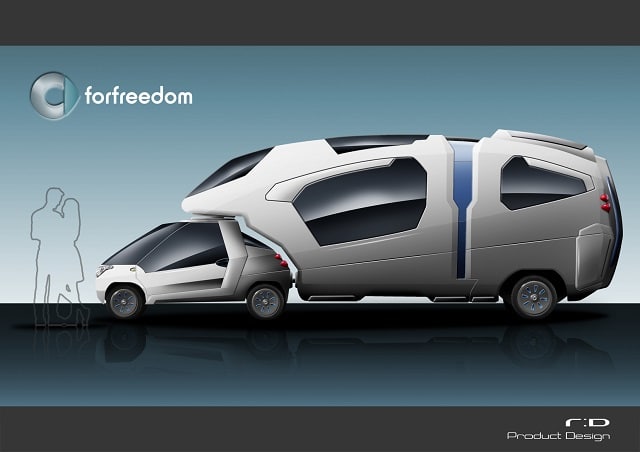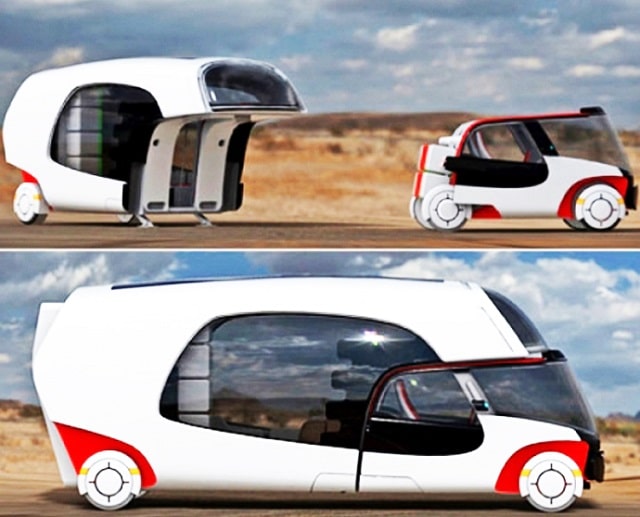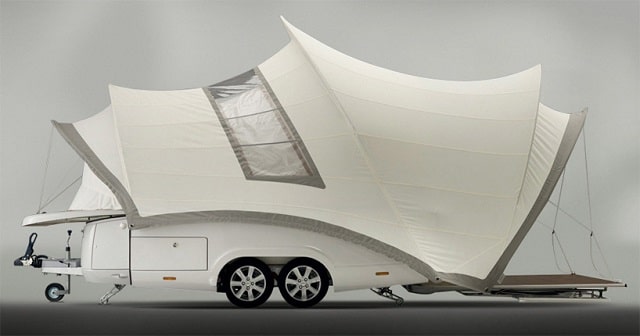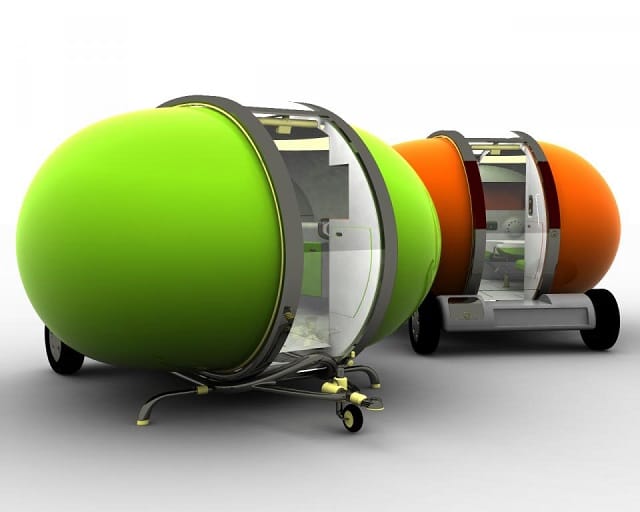ForFreedom Caravan by Robert Williams
While a lot of caravan owners spend their time sealing windows, filling cracks and trying to ensure that the outside world doesn’t penetrate their portable cocoons, Robert William’s new caravan keeps nature firmly out and allows the wind to fly in to the caravan. The Forfreedom caravan splits in half at a right angle, which may not seem a great idea at first but once you see how compact this vehicle is, it soon becomes clear that as long as the weather is good the extra space created by this futuristic design is invaluable. Once spilt open the vehicle’s living space doubles through use of an extendable canopy that creates an al fresco lounge with panoramic views. The caravan is compact, easy to transport, economic on fuel and power, easily connected to vehicles of any size and wonderfully spacious once folded open. British designer Robert William’s new masterpiece comes complete with ingenious storage solutions, a hidden cooking hob, solar heating, 50L water tank and a 60L fridge.

Colim by Christian Susan
COLIM or Colors of Life in Motion is a new caravan design by Christian Susan that at first looks like a futuristic motorhome until, in Transformers like fashion, the front half detaches to separate the car leaving the caravan at the rear. Inside the design is equally as ingenious with platforms, tables and storage units all folding and moving for a fully customisable and flexible living environment. Only designed to transport and sleep two people COLIM’s interior and detachable car provide everything that a couple would need for a long road trip.

Opera by Axel Enthoven
For those sick of not being able to see out of their rear view mirror when towing a caravan Belgian designer Axel Enthoven has come up with an imaginative solution. The compact ‘Opera’ looks like a car trailer when being towed but when fully erect it looks more like a hybrid of a futuristic tent, a caravan and the Sydney Opera House (thus the name). Once inside though it is clear that this is no tent or a simple car trailer (or an opera house unfortunately) but a modern and luxurious living space with stainless steel fittings, leather seats, LED lights, a toilet, two beds, compact storage, hot running water, a wine cabinet and even an espresso bar. No one likes putting up a tent, so award-winning designer Enthoven has also seen to that with an automated electrical assembly motor that erects the structure with the click of a button.

252° Living Area by Stephanie Bellanger and Amaury Watine
The 252° Living Area looks like an oversized children’s toy or perhaps something that you imagine humans will be living in on Mars come 2252. When folded back into a compact 3 wheeled towable unit, the 252° Living Area is compact enough to be pulled by even the smallest cars, but when fanned out in its shell like fashion at a 252° radius (again thus the name), the 252° Living Area actually provides three separate living areas. Designed by Stephanie Bellanger and Amaury Watine these remarkable rooms can be rearranged by a single person into a bathroom, bedroom, kitchen, living room or office. The rooms may look exposed but there is also a clear sliding screen that pulls out completely over the whole structure to protect your precious belongings from outside elements.

The Capsule Caravan by David Tonkinson
With a younger generation now embracing caravanning and camping there is more of a market than ever for stylish and interesting caravan models. British designer David Tonkinson was acutely aware of this when he plotted the designs for his revolutionary Capsule Caravans. Stylish, compact, lightweight, easily towed and small enough to fit into a single parking space, the pod design is a game changer for the new generation of travellers who are hoping to shrug off the shackles of caravanning as an old, dated and unfashionable pastime. The Capsule Caravan is split into two areas: the Service Pod and Comfort Pod. As to be expected the service area is where the running water and facilities are and the comfort area is for living and sleeping in. Another ingenious aspect of the pod is its electro-chromatic window that can switch from opaque to transparent in the flick of a switch letting the world in or shutting it out.














